Underbalanced drilling helps PDO find gas in tight reservoir after 11 unsuccessful wells
By John Bowling, Blade Energy Partners; Raju Hazarika and Dieter Skaloud, Petroleum Development Oman
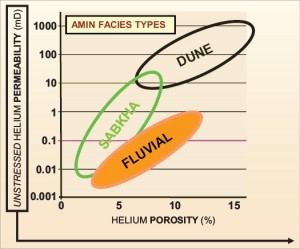
Deep-gas exploration wells in the Fahud Salt Basin in North Oman were traditionally drilled with high mud weights. Due to this conventional drilling practice in low-permeability reservoirs and inherent petrophysical measurement and sampling limitations, a high level of uncertainty remained as to the presence of producible, or commercial, gas.
This resulted in an increased risk when the decision to complete, hydraulically fracture and production test was taken – or conversely, when the well was abandoned. Often, even test results proved inconclusive, with a strong suspicion of impaired reservoir obscuring true production potential.
The well discussed here was the 12th well that penetrated a tight Paleozoic reservoir in the Fahud Salt Basin. The previous 11 wells were high cost and low success, where only one well tested economic gas flow, four were marginally economic and six were ultimately deemed inconclusive.
In the 12th well, the primary objective of the vertical pilot hole was to unambiguously identify mobile hydrocarbons. Underbalanced drilling (UBD) was selected as the key technology to meet this goal. Once that objective was achieved, the budget for drilling a lateral hole, with the aim to optimize production, could be more confidently released. To drill this well underbalanced, by reducing the mud weight from 16 kPa/m to 10.1 kPa/m well-site water, Petroleum Development Oman (PDO) management had to change their well control mindset and take on the risk of major borehole breakouts and stuck pipe.
The result of confronting these two major risks was manageable well control and a largely in-gauge wellbore, allowing high-quality wireline logs in the pilot hole and LWD logs in the lateral section. Most importantly, the flow measured while drilling and during a short UBD production and build-up test. It was the most direct and unequivocal reservoir evaluation available in any of the tight-gas wells of North Oman.
The technical success of this exploration project resulted in the planning of eight more underbalanced exploration wells on neighboring prospects, some with even deeper reservoirs and more pressure uncertainties.
BACKGROUND
One challenge of this reservoir development was to understand the reservoir characteristics of the formation and whether any gas trapped in the matrix is mobile or residual.
The permeability in the target reservoir is predominantly related to an alluvial gross depositional environment, with values from .005 to 1 mD and porosity in the range of 3% to 12%. However, the reservoir quality varies as a function of the dominant depositional facies. These facies are either fluvial (erosion, transportation and deposition of sediments by running water), sabkha (relatively dry flat areas consisting of more fine-grained sediments), or aeolian (desert environments that show evidence of wind transport like dune fields), shown in Figure 1.
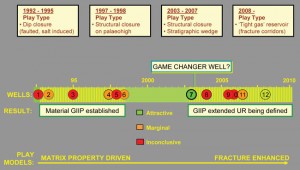
The present-day hydrocarbon saturation is related to the relative timing of hydrocarbon charging and diagenesis (changing from sediment to rock and further compaction), trap formation and the sealing capacity of the cap rock.
The play has changed over time as additional wells have been drilled. In 1992, when the first well was drilled, the trap was simply characterized as a dip closure. By 2008, it had slowly evolved into a tight-gas play, with well placement aimed at sweet spots along fracture corridors.
The well discussed here is the 12th well. The relative success can be seen by the color of the circle on the time line in Figure 2. Only one well out of the previous 11 is understood as economically attractive, while four are counted as marginal and the remainder as inconclusive, after either log interpretation or even production testing.
Normally in PDO, a gas exploration well is logged after it is drilled and completed with a cemented tubing completion based on the logging results. The well is then perforated and hydraulically fractured prior to an extensive production and build-up test. PDO’s typical deep-gas exploration challenges are:
• Deep set objectives have very high UCS (unconfined compressive strength) – hard rock drilling.
• Tectonically stressed formations (borehole breakouts) and unknown local stress orientations.
• Low gas production, possibly due to impairment by the (overbalanced) drilling process.
• Data acquisition across borehole breakouts and tight reservoirs are difficult to interpret, and the petrophysical evaluation is often inconclusive.
• Reliability of downhole tools under HPHT environment.
• Completion, perforation, hydraulic fracturing and well testing are expensive operations, and the investment decision may be based on incomplete or flawed data.
• From spud to receiving data from a production test is usually more than a year.
UBD simplifies petrophysical evaluation by directly testing the mobility of hydrocarbons. Additionally, UBD adds vital and early information for the decision process by reducing the risk of completing and testing reservoirs that have no mobile hydrocarbons. Therefore, UBD was accepted as a key technology to establish the validity of this tight-gas play.
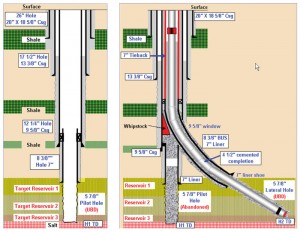
PLANNING
The exploratory pilot hole was planned with the sole objective of identifying movable hydrocarbons. Subject to meeting this objective, a high-angle sidetrack was planned to further explore for naturally occurring fractures that might enhance production potential and to determine the commerciality of the discovery.
The target well location is similar to well 7 in the play, where faulting/ fractures cross on a structure. A deviated well through the reservoir interval to find fractures was selected as the optimal well plan to improve the attractiveness of the play because the matrix permeability and porosity are so low. The objectives for each hole section were made as simple as possible to allow for all the uncertainty that is part of exploration drilling.
A number of geomechanical studies were carried out at various phases of planning and constructing this well. First, a pre-drill assessment was done to evaluate the feasibility of UBD in the target reservoir based on geomechanical models derived from previous studies on nearby wells.
This was further refined by the data collected via petrophysical logs across the 8 3/8-in. section in the pilot hole (Figure 3) with a better understanding of the stress orientations specific to the well. The geomechanical analysis was extended by updating the model using logs and post-drill information gathered from the 5 7/8-in. section of the pilot hole.
Analysis of existing fractures and hole breakouts from the image logs acquired in the pilot hole was used to fine-tune the orientation of the sidetrack well for a best compromise between drillability, ability to hydraulically frac and achieve maximum. In 2006, PDO set the milestone of trying UBD in the strategic gas exploration improvement plan. However, there were many issues to resolve before starting a trial in gas exploration. Borehole breakouts in tectonically disturbed formations is a major issue in selecting optimum drilling assemblies when considering stuck at the bit or bottomhole assembly (BHA), as well as in acquiring quality petrophysical data across a severely broken-out hole section. Maintaining an adequate mud hydrostatic while drilling across tectonically stressed formations was the effective measure to improve borehole stability. To validate the borehole breakout phenomena and fracture study, logging-while-drilling (LWD) tools were used in a gas exploration well in 2006.
In 2007, PDO planned a managed pressure drilling (MPD) trial to drill and trip with the well near balance to improve drilling performance while managing the risks of an overpressured reservoir with borehole stability issues. Although the planning was completed, the trial was aborted before rigging up the equipment on location due to the premature failure of a deep-set, cemented downhole isolation valve immediately after installation. The plan was to use a low solids mud system. The objectives for combining both MPD and the low solids mud system were:
• Reduction in reservoir impairment (with reduced overbalanced conditions from MPD).
• Manage expected borehole breakouts.
• Early decision on production testing by dialing down the bottomhole circulating pressure to determine if movable hydrocarbons exist.
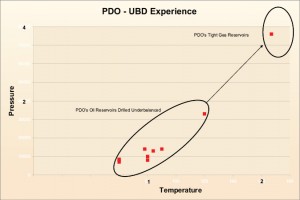
In 2008, due to the need to reduce uncertainties in reservoir characterization and to facilitate improved decision-making on completion and test programming, PDO’s well engineering and exploration teams decided to use UBD on a trial basis. The well engineering team faced many challenges in planning and implementing UBD and had to engineer appropriate measures to deliver a fit-for-purpose well within an ambitious time frame.
The primary concern was the wide range of uncertainty in prognosed pore pressure, which had a 17% difference from low to high. The expected high reservoir pressure set the requirement for an IADC ranking of the well as a UBD Level 5. The success of the UBD application greatly depended on the selection of the underbalanced drilling fluid to obtain an effective drawdown on this tight reservoir. A reasonably accurate estimation of the actual pore pressure was therefore of vital importance to choose between the two UBD fluids (crude or well-site water) for this application.
Historically, measurement of pore pressure by wireline logs from this tight rock has not been successful due to borehole geometry and temperature-related problems. However, the same could be successfully estimated by extending the 8 3/8-in. section to penetrate the top of the reservoir with a mud weight less than the lower boundary of the prognosed pore pressure. Then, if an influx of reservoir fluid is detected, the mud weight is increased in increments until no further influx is detected.
The reservoir pressure for planning estimates is two times and the reservoir temperature is 1.5 times higher than PDO’s current UBD experience (Figure 4). To manage the high temperature, a mud cooler was mobilized for the intermediate section. It was connected to the UBD tank farm to manage the fluid temperature in the tank farm while drilling the reservoir interval. The mud cooler significantly improved on-site HSE concerns related to circulating hot mud, as well as the reliability of downhole tools.
There were many secondary issues related to planning this well. The 9 7/8-in. casing required to satisfy PDO’s policy on design factors for anticipated production loads were not readily available to deliver well objectives on time. The PDO standard 9 5/8-in. casing used in conventional gas exploration well designs was used pending a well upgrade with a 7-in. tie-back during the completion phase.
The maximum allowable annular surface pressure (MAASP) of the 9 5/8-in. was less than a gas kick completely evacuating the well. Therefore, a limited kick design philosophy was adopted for drilling load scenarios to limit the maximum volume of produced gas during the course of UBD operations within the design and operating envelopes of the 9 5/8-in. casing.
The second concern was the known borehole instability and breakouts causing stuck pipe while drilling. To avoid breakouts and interbedded shale-related problems above the target reservoir, a 7-in. liner was set 20 m into the top of the reservoir, allowing 5 7/8-in. hole to be drilled in UBD mode across the target objectives (Figure 3). This was a step-change from the conventional gas exploration well design where the 8 3/8-in. hole section is typically drilled to the well total depth.
Use of diamond-impregnated (impreg) bits driven by turbines or motors rated to high speed and high temperature were considered the most efficient drilling assemblies to drill this reservoir. These bits provide longer life compared with hard-formation tricone insert (TCI) bits on simple rotary drilling assemblies. However, use of a turbine or high-speed motor in combination with impreg bits are limited in tectonically stressed formations due to the potential for getting stuck, followed by expensive recovery operations.
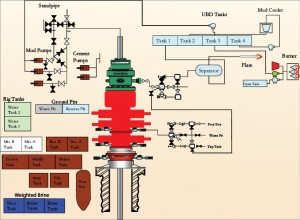
The risk of borehole breakouts was expected to be more severe in this highly faulted geological environment, especially in an underbalanced drilling condition. This led to the selection of simple rotary drilling assemblies, which are less prone to getting stuck in a tectonically disturbed environment. The trade was a reduced potential for getting stuck compared with a more limited run life requiring more frequent trips to drill the planned reservoir.
The reservoir is underlain by salt, and there was concern of getting stuck with underbalanced fluid due to salt plasticity. The rig selected for this UBD project had been involved in drilling gas exploration wells for many years; thus, the office and rig-site teams were well experienced with challenges related to conventional deep-gas exploration. However, none of the crew or the supervisors was familiar with UBD operations. Job-specific UBD training programs for the office and the well-site team were required.
The rig was equipped with a 5,000-psi rated circulatory system, which is not suitable for pressure requirements to kill the well using the driller’s method of well kill, as well as the required UBD/kill fluid change-overs. A 10,000 psi-rated cementing unit for displacement jobs and standing by for well-kill operations reduced the well control risk and eliminated the requirement of upgrading the standpipe pressure rating.
The rig selected was a Kelly-driven rig with a BOP stack consisting of a 5,000-psi annular and 10,000-psi pipe and shear blind rams. Attempts to acquire a portable top drive system for this application proved unsuccessful due to contract issues. With the unavailability of a top drive system and the shear rams not designed to cut through the hex kelly, the existing BOP setup did not allow for high-pressure well control with a stuck string while drilling. A 10,000-psi annular BOP, including a spare accumulator unit, was mobilized to obtain 10,000-psi BOP redundancy and the secondary barrier while drilling.
Although PDO has a UBD unit operating full time, this was not available due to an ongoing batch-drilling campaign in a shallower oil development. A second unit was specified and mobilized under the existing UBD contract. The equipment selected was suitable for drilling with either crude oil or well-site water to allow for the high uncertainty in reservoir pressure.
A few modifications to the existing rig were required as only the rig pumps and the rig choke manifold were used for the underbalanced operations. Solids in the returns from the well were held in the first and second tanks in the tank farm instead of using shakers or a centrifuge for separation. A crude burner was mobilized because of the high uncertainty of production from the well and the expectation of condensate in the produced gas (Figure 5).
The planning process required detailed planning in accordance with the well delivery process milestones and proper documentation to obtain necessary approval from PDO’s senior management and the designated well control custodian. Strict adherence to PDO’s well control barrier policy was maintained during all phases of well construction and underbalanced operations.
The planning required various flow modeling scenarios to generate a basis of design for the UBD equipment. Based on the flow modeling, a well control matrix (Figure 6) was formulated and followed to limit the maximum volume of gas produced during UBD operations. This matrix provided the guidelines to remain within the design and operating envelopes of the 9 5/8-in. casing and the UBD well control equipment.
After the equipment was selected, a process and instrumentation diagram (P&ID), equipment layout drawings and detailed operating procedures were generated. A hazard identification workshop followed by detailed hazard analysis and operability study was carried out involving the rig and UBD contractors, PDO well engineering, the consultant (Blade Energy Partners) UBD engineers and the Shell global UBD principal technical expert.
From this workshop, about 150 action points were generated to improve the equipment design, procedures and operations plan. A drilling program, a well engineering management review and emergency response procedures were generated. The drilling program was reviewed during two drill-the-well-on-paper (DWOP) sessions. The rig and UBD contractor generated a bridging document for UBD operations to fit with the rig safety case.
Planning for this well began less than four months before the rig was mobilized to location and was completed in nine months. This relatively short planning time was able to be achieved due to PDO’s high motivation to try UBD, in-house experience in UBD operation, access to Shell’s global tight-gas UBD experience, mature infrastructure near the well location, and the short mobilization distance and time from the UBD contractor’s regional workshop to the rig site.
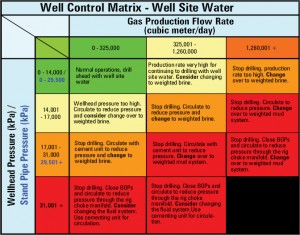
OPERATIONS – PILOT HOLE
The 8 3/8-in. section strategically penetrated the target reservoir with the existing 13.4 kPa/m water-based mud. This mud weight was less than the lower boundary of the prognosed pore pressure to ensure an influx of mobile reservoir fluids. As drilling progressed deeper into the reservoir to obtain the required logging pocket, high gas shows in the form of background gas, connection gas, swabbed gas and severe bubbling at surface became evident.
The drilling mud density was increased in small increments to counter the gas influx into the mud system. The final mud density required to minimize gas and include a trip margin was 16.3 kPa/m. These hydrocarbon indications helped in narrowing down reservoir and geological uncertainties and gave the exploration team more confidence in pursuing the proposed objectives of this project. It also allowed the well engineering team to determine the reservoir pressure and select the appropriate UBD and kill fluid for the reservoir interval.
As the reservoir was found overpressured, well-site water was selected as the drilling fluid to best manage the circulating pressures while drilling underbalanced and to minimize the risk of handling hydrocarbons on the rig site. Well-site water provided a 38% drawdown to the pressure at the top of the reservoir. After the 8 3/8-in. section was successfully logged, a 7-in. liner was installed as planned. The UBD equipment was mobilized to location after the 7-in. liner was run in hole.
The rig-up and commissioning took longer than planned due to equipment and certification issues. This was a significant lesson learned; future operations will rely on a commissioning exercise before mobilizing the equipment to location to minimize operational delays.
Mobilization of new equipment needed for operations arrived over the road with one border crossing in less than one week. Once the UBD equipment was rigged up according to the final version of the P&ID and integrity-tested, a dedicated trip was made to clean the 7-in. liner and perform the planned formation integrity test. This trip was also used to perform the necessary well control drills covering all scenarios and to provide hands-on training to the on-site teams covering the upcoming UBD operations.
These training procedures proved effective in successful UBD and well-kill operations, as well as achieving the required communication and interface management within the multidisciplinary rig site team.
The 5 7/8-in. vertical pilot hole was drilled in four bit runs using simple packed-hole rotary assemblies and TCI bits from 20 m below the top of reservoir to TD at the top of salt covering all the targeted reservoirs. This hole section was drilled without any issues to stuck pipe, high torque or high surface pressure. The well was killed on trips to simplify operations and avoid live well tripping issues. The well kill required a cement pump and bypassed the rig pumps and underrated stand pipe.
The average on-bottom ROP while drilling across the reservoir section was 2.5 times faster than the conventional drilling ROP at the top of the reservoir. The running hours on the TCI bits were also better than the established bit life on similar sections drilled in conventional mode.
Drilling this section proceeded according to plan, apart from a number of temperature-related measurement-while-drilling (MWD) and annular pressure-while-drilling (APWD) tool failures. Low-rate gas production started during the first bit run, but the rates were not measurable with the gas meters hard-piped to the separator.
A junior orifice plate meter was mobilized to measure the low-rate gas production. The meter provided gas rates while drilling that were combined with wireline log data for reservoir evaluation. Intermediate wireline logs helped establish hole conditions, and the total depth logs correlated well with gas production to characterize the reservoir. The logs indicated limited breakouts from drilling with an underbalanced fluid. The majority of the gas production came from the interfaces between the three reservoir facies, with incremental increasing production from microfracturing in the target Reservoir 1.
The measurement of movable hydrocarbons from the pilot hole meant that the primary well objective was achieved. The lateral trajectory was planned based on lessons from the pilot hole interval.
OPERATIONS – LATERAL
The geomechanical analysis done with the pilot hole logs and UBD-acquired reservoir information was used to modify the design of the sidetrack well. The lateral hole trajectory was planned as a highly deviated well through all three reservoir facies to benefit from the production at the interfaces. The azimuth was chosen to improve the chances of intersecting naturally occurring, partially open fractures.
After drilling the buildup section in the 8 3/8-in. sidetrack hole, the short tangent section was extended to enter the top of the reservoir about 350 m away and 7 m true vertical depth (TVD) shallower than the pilot hole. The 7-in. liner was set at the top of reservoir and the liner cleaned out. The well was then displaced to underbalanced fluid for a short buildup test. The wellhead pressure built up to 10,000 kPa during the two-hour test, with 2 m of reservoir formation open.
The first 100 m of the 5 7/8-in. tangent section was continued in UBD mode and followed the directional plan, with 2 TCI bit runs on packed-hole rotary assemblies with an average ROP comparable to the pilot hole. A steerable turbine and diamond-impregnated bit combination were then introduced for steerability and performance drilling to reduce the number of trips and associated well-kill time.
However, maintaining directional control to continue along this highly inclined tangent section across a potential fault zone proved extremely difficult. Two consecutive BHA failures occurred, one at the MWD collar and the other at the turbine shaft, due to high dogleg severity, resulting in a rapid drop in inclination while trying to maintain trajectory across the possible fault zone.
After successful recovery of the two dropped assemblies, drilling was continued with TCI bits on rotary assemblies to avoid further twist-off of the BHA. The hole section was drilled in a total of eight bit runs from the top of the reservoir until total depth (TD) in target Reservoir 3 above the salt, with significant improvement in ROP comparable to the pilot hole.
Prior to drilling, a stimulation chemical to reduce surface tension was added to the kill weight mud to reduce water blocking due to mud filtrate invasion into the reservoir. After each well kill, the gas production had only negligible reduction, indicating that this treatment was possibly effective. Therefore, at TD, a production test representative of an unstimulated productivity index (PI) was measurable.
The initial production test at TD, which included a flow and buildup test, was conducted with a circulation rate of 1,100 lpm and 500 lpm using MWD and APWD tools. There were issues with the LWD tools in each bit run, and it was important to obtain the PI data to select the completion design. The PI was nonlinear for the two rates, with the PI increasing with drawdown.
While this production test provided limited information, it was sufficient to determine that an unstimulated PI would not be economic. Therefore, a cemented 4 ½-in. completion and a 7-in. liner tieback designed for hydraulic fracturing and production loads were installed in the well. All additional work scope after drilling the well were conducted with the knowledge that movable hydrocarbons were present. The challenges for completion and production lie in determining the optimal stimulation method.
RESULTS
• The well was completed with no harm to people and environment despite the introduction of new equipment, procedures and non-routine operations.
• The pilot hole proved the presence and mobility of gas, achieving the objective.
• Both the pilot and the lateral holes were successfully drilled with a fluid gradient 38% lower than the pore pressure at the top of the reservoir without any well control or stuck pipe issues.
• The matrix production was low, but microfracturing that contributed to production was identified on logs. Gas production was recorded from intervals that may have been discarded by petrophysical log interpretation as non-reservoir or water bearing. Surprisingly, interfaces between three reservoir units were primary contributors to gas production.
• A low-rate gas meter is required for measuring gas production because the standard meter fixed to a UBD separator does not have the proper range.
• The addition of a gas well stimulation chemical to the kill mud in the lateral hole appears to have reduced production impairment after each bit trip.
• The lateral hole was a third longer than the pilot hole but three times more productive.
• A 150% ROP improvement was established by employing UBD technology.
• The faulted and tectonically stressed reservoir interval imposed challenges for maintaining directional control.
• The high reservoir temperature led to multiple LWD failures while drilling, but high-temperature LWD tools for future wells were successfully tested.
• A production test on the lateral hole was successfully performed while circulating to ensure pressure data was recorded and transmitted to surface.
• The well was completed with a cemented tubing string for hydraulic fracturing and a long-term production test.
• The technical success of this project resulted in the planning for nine more tight-gas exploration wells.
CONCLUSIONS
• The most definitive way to prove the presence and mobility of gas in a tight reservoir is to produce and measure the production rate while drilling.
• Tight reservoirs with high pressures do not present the same well control risk as conventional gas reservoirs with high pressures.
• The pilot hole showed reduced production in UBD after every bit trip, caused by preceding well-kill operations.
• “Live well tripping” presents opportunities for enhanced productivity during UBD and will eliminate long and expensive fluid change-overs between UBD and kill fluid.
• Fit-for-purpose rig and equipment selection for the intended work scope would significantly reduce the time and cost of well construction.
• Successful implementation of UBD on this well has changed PDO’s deep-gas exploration strategy. The proven benefits will enable accelerated decision-making on completion and stimulation strategy. This step-change will contribute toward delivering a more commercially attractive tight-gas exploration programme.
Acknowledgements: The authors would like to thank the Ministry of Oil and Gas and the partners in PDO for allowing publication of this paper. Special appreciation goes to John Ramalho, Shell, for his tireless efforts in supporting the planning and implementation of this project.
SPE/IADC 130320, “Finding Gas Using Underbalanced Drilling in a Tight Reservoir,” was presented at the 2010 SPE/IADC Managed Pressure Drilling and Underbalanced Operations Conference and Exhibition, Kuala Lumpur, Malaysia, 24-25 February 2010.



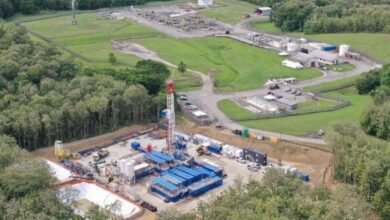
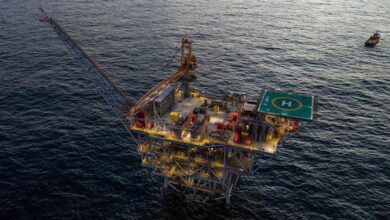
Its a nice article